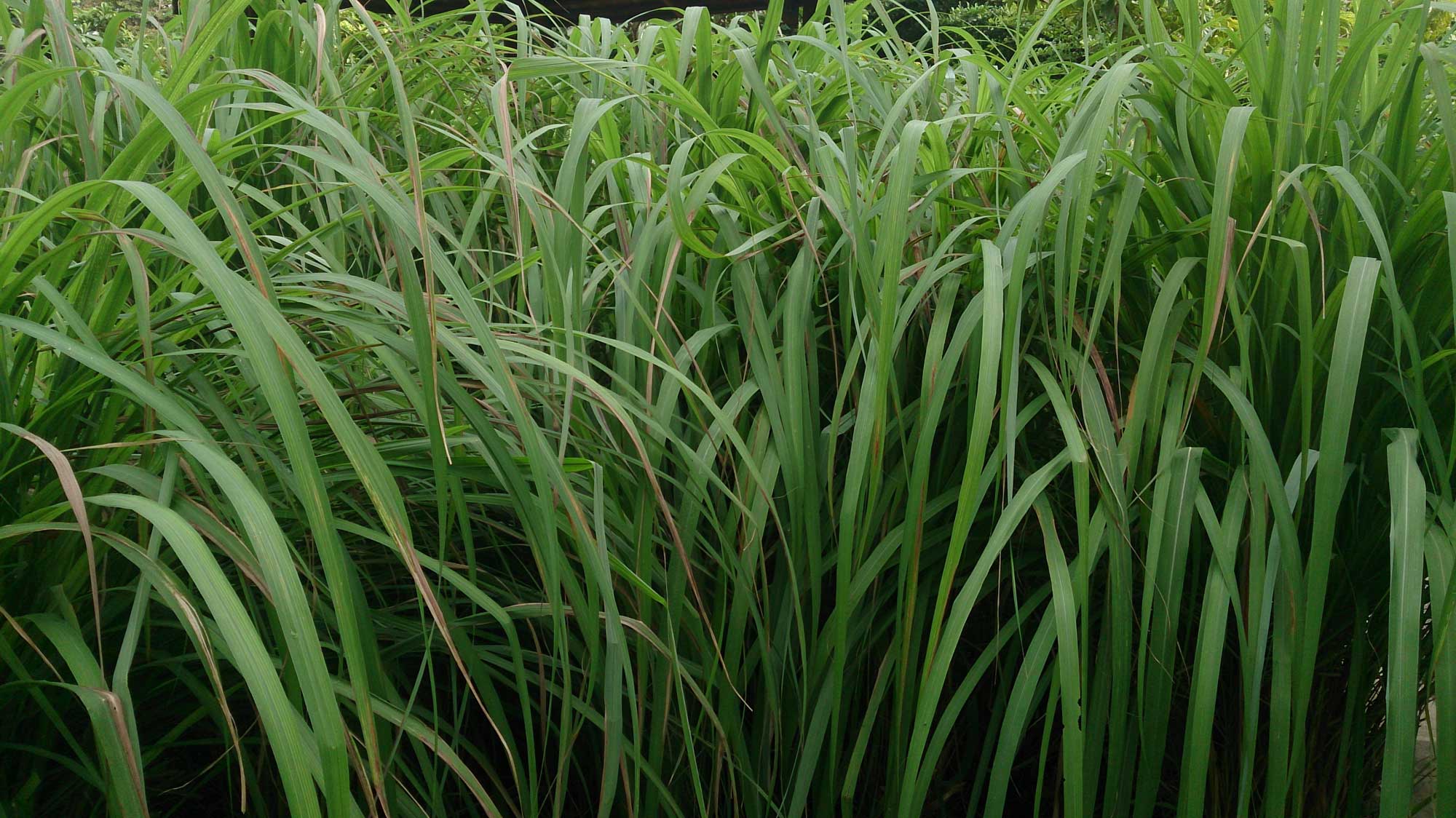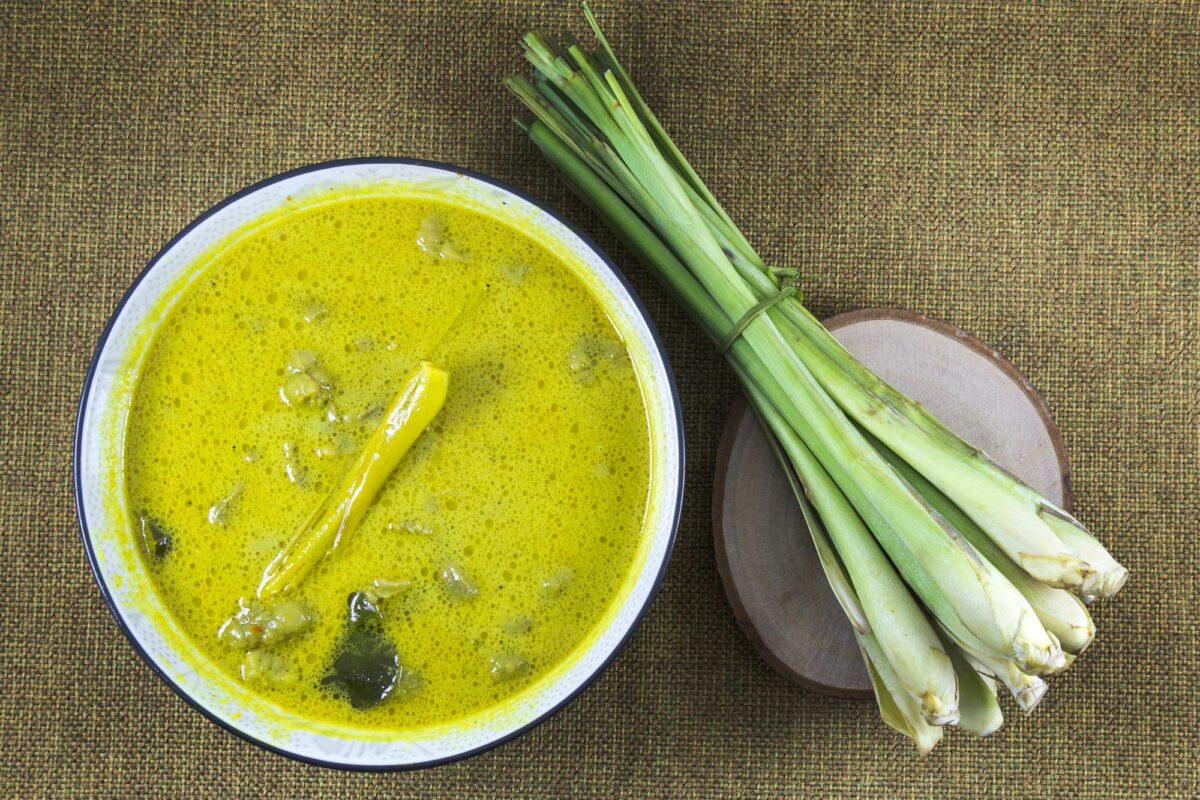Page snapshot: Quick facts about essential oil-producing grasses in the genus Cymbopogon (citronella, lemongrass, and palmarosa).
Topics covered on this page: What are citronella, lemongrass, and palmarosa?; Where did citronella, lemongrass, and palmarosa come from?; How are citronella, lemongrass, and palmarosa used?; How are citronella, lemongrass, and palmarosa grown?; Where are citronella, lemongrass, and palmrosa grown?; Resources.
Credits: Funded by the National Science Foundation. Any opinions, findings, and conclusions or recommendations expressed in this material are those of the author(s) and do not necessarily reflect the views of the National Science Foundation. Page by Elizabeth J. Hermsen (2023).
Updates: Page last updated March 6, 2023.
Image above: Lemongrass (Cymbopogon citratus) is used in cooking. Photo by Herusutimbul (Wikimedia, Creative Commons Attribution 4.0 International license, image resized).
What are citronella, lemongrass, palmarosa?
Citronella, lemongrass, and palmarosa, are all common names for grasses in the genus Cymbopogon, a genus that includes more than 70 species of tropical grasses that produce essential oils. Essential oils are oils containing volatile compounds that give off distinctive scents. Some species of Cymbopogon are grown commercially as herbs or as sources of essential oils. The main commercially exploited species are:
- Citronella or citronella grass: Ceylon citronella (Cymbopogon nardus) and Java citronella (Cymbopogon winterianus). These grasses should not be confused with the citronella plant (Pelargonium citronellum, a type of geranium). The essential oils from these plants, sold as citronella oil, contain various concentrations of geraniol, citronellal, and cintronellol.
- Lemongrass: West Indian lemongrass (Cymbopogon citratus), East Indian lemongrass (Cymbopogon flexuosus), and Jammu lemongrass (Cymbopgon pendulus). The essential oils in these grasses contain a compound called citral, which is also found in the fragrant peels of citrus fruits.
- Palmarosa: Cymbopogon martini var. motia. The essential oil in this grass is largely made of up geraniol and is considered to have a scent similar to roses (Rosa).
Other species, such as karnkusa grass (Cymbogon iwarancusa), are also used as sources of essential oils or as herbs or medicinal plants. Some other Cymbopogon oils are gingergrass oil (Cymbopogon martini var. sofia), karnkusa oil (Cymbogon iwarancusa), and jamrosa or jamarosa oil (C. iwarancusa x C. nardus)

West Indian lemongrass (Cymbopogon citratus), Singapore. Photo by Mokkie (Wikimedia Commons, Creative Commons Attribution-ShareAlike 4.0 International license, image resized).

Ceylon citronella (Cymbopogon nardus). Photo by Mokkie (Wikimedia Commons, Creative Commons Attribution-ShareAlike 4.0 International license, image resized).

Palmarosa (Cymbopogon martini) plants (left) and detail of flowering inflorescences (right). Left photo by Ravi Upadhyay India (Wikimedia Commons, Creative Commons Attribution 4.0 International license) and right photo by Agasthiar1 (Wikimedia Commons, Creative Commons Attribution 4.0 International license), images cropped and resized.
Where did citronella, lemongrass, and palmarosa come from?
Cymbopogon is native to broad regions of Africa, Oceania, and large parts of southern Asia ranging from Turkey and the Sinai and Arabian peninsulas to southern China, North and South Korea, and Japan and regions to the south. The genus has been introduced to large parts of the tropical to subtropical Americas.
How are citronella, lemongrass, and palmarosa used?
Cultivated species of Cymbopogon are most important as sources of essential oils. Some of their oils are bottled and sold directly to consumers for aromatherapy and folk medicinal purposes. Much of the essential oil from Cymbopogon plants, however, is used in the food, fragrance, and cosmetics industries, as well as for other industrially produced products.
Citronella oil in particular is used in "natural" insect repellants and other insect-repelling products, like candles. Citronella oil usually comes from citronella grass rather than the citronella plant (Pelargoniium citronellum).
Lemongrass is used as an herb (a flavoring ingredient) in certain Asian cuisines, or it may be dried and used in herbal teas. Lemongrass is also sometimes grown as an ornamental.
Plant material left over after the essential oils have been extracted from plant tissues can be used as animal feed, fertilizer, or for other purposes.

Bottled essential oils. Anne (flickr, Creative Commons Attribution-NonCommercial-ShareAlike 2.0 Generic license, image cropped and resized).

A candle containing citronella oil that is marketed as a repellant for mosquitos and other insects. Roger Ward (flickr, Creative Commons Attribution 2.0 Generic license).

Lemongrass for sale, Philippines. Photo by Obsidian Soul (Wikimedia Commons, CC0 1.0 Universal/public domain dedication).

Lemongrass harvested from a home garden, British Columbia, Canada, 2021. Photo by Dennis Sylvester Hurd (flickr, Creative Commons Attribution 2.0 Generic license, image resized).
How are citronella grass, lemongrass, and palmarosa grown?
These grasses are grown in cultivated fields and are often propagated asexually from pieces of plants. Palmarosa may be cultivated from seed or collected from the wild.
Cymbopogon grasses are harvested by cutting the plants above their bases and collecting the leaves and other aboveground parts (if they have been allowed to develop). Cymbopogon grasses can be cut and allowed to regrow several times during the same growing season. The same crop may be harvested over several growing seasons before it needs to be replanted.

Women harvesting lemongrass, Nepal, 2017. Photo by Chandra Shekhar Karki/CIFOR (flickr, Creative Commons Attribution-NonCommercial-NoDerivs 2.0 Generic license).
Where are citronella grass, lemongrass, and palmarosa grown?
Statistics on cultivation or collection of these grasses and production of essential oils are not as firm as those available for major crop plants like maize and sugarcane. Citronella oil is largely produced in China and Indonesia, although it also comes from many other tropical countries in the Americas, Africa, and Asia. Lemongrass oil is produced in Brazil, Guatemala, China, India, and other countries. Palmarosa oil is produced in India and other tropical countries.
Resources
Articles & reports
Baker, B. P., and J. A. Grant. Lemongrass oil profile. New York State Integrated Pest Management Program and Cornell Cooperative Extension. PDF: https://ecommons.cornell.edu/bitstream/handle/1813/56130/lemongrass-oil-MRP-NYSIPM.pdf
Books
Akhila, A. (ed.). 2010. Essential oil-bearing grasses, the genus Cymbopogon. CRC Press, Taylor & Francis Group, Boca Raton, Florida.
Bahl, J. R., A. K. Singh, R. K. Lal, and A. K. Gupta. 2018. High-yielding improved varieties of medicinal and aromatic crops for enhanced income. Pp. 247-265 in B. Singh, B. and K. Peter (eds.) New Age Herbals. Springer, Singapore. https://doi.org/10.1007/978-981-10-8291-7_12
Seidemann, J. 2005. World spice plants: Economic usage, botany, taxonomy. Springer-Verlag Berlin Heidelberg.
Simpson, B. B., and M. C. Ogorzaly. 2001. Economic botany, plants in our world, 3rd ed. McGraw Hill Higher Education, New York, New York.
Skaira, B. P., P. P. Joy, S. Mathew, and G. Mathew. 2006. Lemongrass. Pp. 400-219 in K. V. Peter (ed.), Handbook of Spices vol. 3. Woodhead Publishing Pvt., Ltd., Cambridge, U.K.
Scientific articles
Li, M., B. Liu, C. Bernigaurd, K. Fischer, J. Guillot, and F. Fang. 2020. Lemongrass (Cymbopogon citratus) oil: A promising and ovicidal agent against Sarcoptes scabiei. PLoS Neglected Tropical Diseases 14(4): e0008225. https://doi.org/10.1371/journal.pntd.0008225



